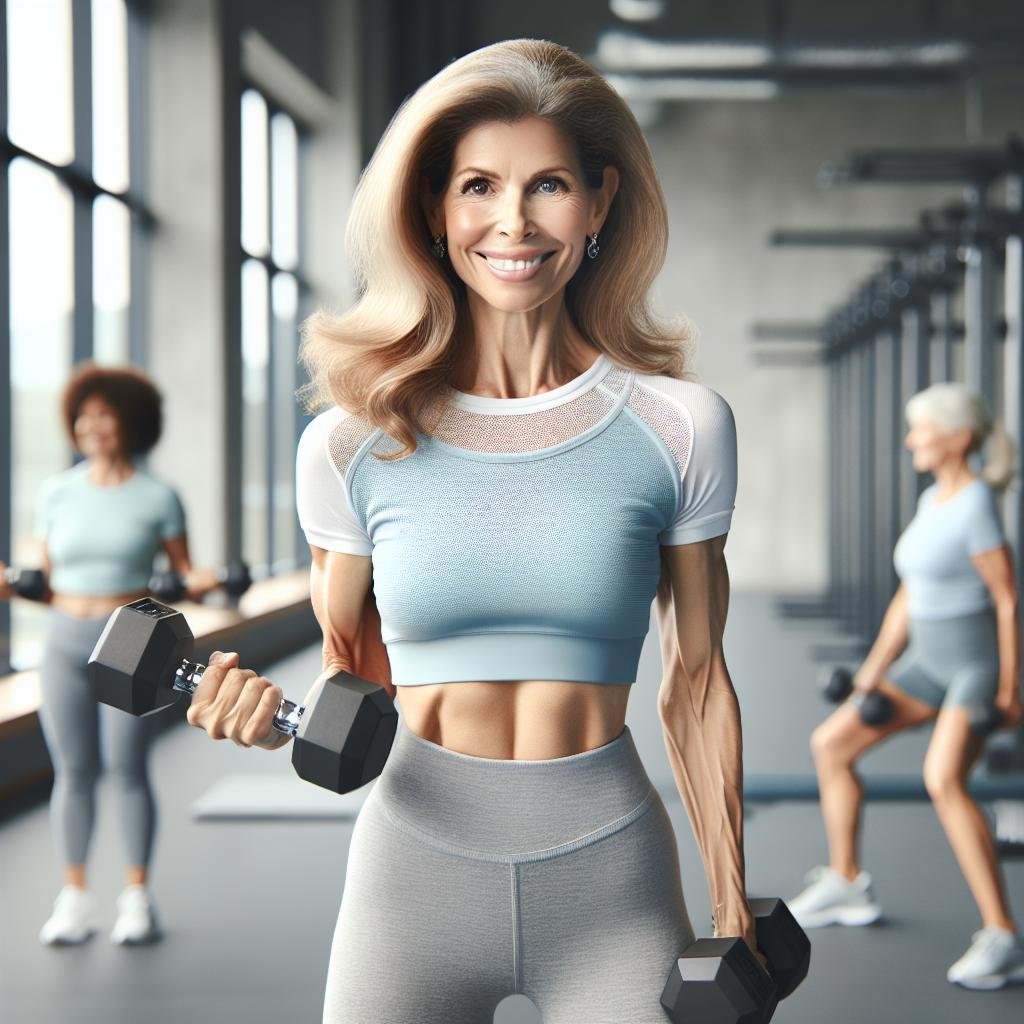
Weight Lifting Over 50: Essential Anti-Aging Exercise Guide
Weight lifting after 50 isn’t just beneficial—it’s essential for maintaining strength, bone density, and overall health as we age. Many adults wrongly believe that resistance training becomes too risky as they get older. The truth is quite the opposite. Regular strength training can actually reverse many age-related declines in muscle mass and function.
This comprehensive guide explores why lifting weights should be a cornerstone of your fitness routine after hitting the half-century mark. I’ll share expert-backed strategies for safely building strength, preserving mobility, and enhancing your quality of life through properly designed resistance training.
Why Weight Training Becomes Crucial After 50
As we age, our bodies naturally begin to lose muscle mass—a condition called sarcopenia. This decline accelerates after 50, with adults typically losing 3-5% of muscle mass each decade. The consequences extend far beyond appearance.
Dr. Jennifer Kerns, a sports medicine specialist at Mayo Clinic, explains: “Weight training directly counteracts sarcopenia by stimulating muscle protein synthesis and promoting the retention of lean muscle mass, even in older adults.”
The benefits of consistent weight training after 50 include:
- Preservation and building of lean muscle mass
- Increased metabolic rate, aiding weight management
- Improved bone density, reducing fracture risk
- Enhanced balance and coordination
- Better glucose metabolism and insulin sensitivity
- Reduced risk of chronic diseases
- Improved mental health and cognitive function
Perhaps most importantly, regular strength training helps maintain functional independence as you age. This means continuing to perform daily activities—from carrying groceries to playing with grandchildren—without assistance.
Debunking Common Myths About Weight Training After 50
Before diving into how to start, let’s address some persistent misconceptions that keep many older adults away from the weight room.
Myth 1: “Weight lifting is dangerous for older adults”
When performed with proper form and appropriate progression, weight training is remarkably safe for older adults. In fact, research shows that supervised resistance training programs have injury rates lower than many other common activities.
Myth 2: “It’s too late to build muscle after 50”
Studies consistently demonstrate that adults in their 60s, 70s, and even 80s can build significant muscle mass through resistance training. Your body retains the ability to adapt to strength training throughout life.
Myth 3: “Weight training will make women bulky”
Women typically lack the testosterone levels required for substantial muscle growth. Instead, resistance training creates a toned, firm appearance while building functional strength and bone density—particularly important for postmenopausal women.
Myth 4: “Lighter weights and more reps are best for older adults”
While higher reps have their place, research indicates that moderate to heavier weights (with proper form) produce the best results for maintaining and building muscle mass in older adults.
Getting Started: Your Weight Training Framework After 50
Beginning a weight training program after 50 requires thoughtful planning. Here’s a framework that balances safety with effectiveness:
Consult Healthcare Providers First
Before beginning any new exercise program, consult your physician, especially if you have pre-existing conditions like heart disease, arthritis, or osteoporosis. They can provide specific guidelines based on your health status.
Start With Professional Guidance
Consider working with a certified personal trainer experienced in training older adults. Even a few sessions can teach proper technique, appropriate exercise selection, and safe progression strategies.
Focus on Fundamental Movement Patterns
Build your program around these essential movement patterns:
- Squat pattern: Builds lower body strength critical for daily activities
- Hinge pattern: Strengthens posterior chain, improves posture
- Push movements: Develops chest, shoulders, and triceps
- Pull movements: Strengthens back and biceps, counters hunched postures
- Carrying exercises: Improves grip strength and functional capacity
Prioritize Proper Form Over Weight
Proper technique always trumps how much weight you’re lifting. Master the movement patterns with lighter weights before progressively increasing the load.
Sample Weight Training Program for Adults Over 50
Here’s a simple yet effective program suitable for most healthy adults over 50. Perform this routine 2-3 times per week with at least one day of rest between sessions.
Warm-Up (5-10 minutes)
- 5 minutes of light cardio (walking, cycling)
- Dynamic mobility movements (arm circles, gentle twists, leg swings)
- Bodyweight movement preparation (5-8 reps each: wall squats, countertop push-ups, standing rows with resistance band)
Main Workout
Session A:
- Goblet Squats: 3 sets of 8-12 reps
- Seated Cable Rows or Band Rows: 3 sets of 10-15 reps
- Chest Press (machine or dumbbell): 3 sets of 10-12 reps
- Step-Ups: 2 sets of 10-12 reps each leg
- Standing Calf Raises: 2 sets of 15-20 reps
Session B:
- Romanian Deadlifts: 3 sets of 8-12 reps
- Seated Shoulder Press: 3 sets of 10-12 reps
- Lat Pulldowns: 3 sets of 10-15 reps
- Leg Press: 3 sets of 10-15 reps
- Farmer’s Carries: 2 sets of 30-40 seconds
Cool Down (5-10 minutes)
- Static stretching for major muscle groups
- Deep breathing exercises
Rest 1-2 minutes between sets, and 2-3 minutes between exercises. Focus on controlled movements, especially during the lowering (eccentric) phase of each exercise.
Real-Life Success: Mary’s Transformation at 58
Mary, a 58-year-old former office manager, began weight training after being diagnosed with osteopenia (reduced bone density). Like many, she initially feared weights would be too challenging or risky at her age.
“I was convinced I’d hurt myself or that I was too old to see any real benefits,” Mary recalls. “I started with just body weight exercises and very light dumbbells, working with a trainer once weekly.”
Within six months, Mary had progressed to squatting with 65 pounds and deadlifting 85 pounds. Her follow-up bone density scan showed significant improvement, and she reported feeling “stronger than in my 30s.”
“The functional improvements surprised me most,” she says. “I can play with my grandchildren without getting tired, carry all my groceries in one trip, and my persistent back pain has almost completely disappeared.”
Mary’s experience reflects what research consistently shows—it’s never too late to reap the benefits of strength training.
Essential Tips for Safe and Effective Weight Training After 50
Listen to Your Body
Distinguish between productive muscle fatigue and potential injury signals. While some muscle soreness is normal, sharp pain, joint discomfort, or persistent aches warrant attention and possibly modification.
Emphasize Recovery
Recovery becomes increasingly important with age. Ensure you’re:
- Getting adequate sleep (7-9 hours)
- Consuming sufficient protein (1.2-1.6g per kg of body weight)
- Staying well-hydrated
- Incorporating active recovery days (walking, swimming, yoga)
Progress Gradually
Increase weight, sets, or repetitions conservatively—about 5-10% when an exercise becomes too easy. This approach minimizes injury risk while still promoting adaptation.
Address Mobility Limitations
Many older adults have mobility restrictions from past injuries or sedentary lifestyles. Work with a physical therapist or qualified trainer to address these limitations while safely progressing your strength program.
Consider Joint-Friendly Alternatives
If certain exercises cause joint discomfort, numerous alternatives can work the same muscle groups with less stress on sensitive areas:
- Replace barbell bench press with chest press machines or pushups
- Substitute traditional squats with box squats or leg press
- Use trap bar deadlifts instead of conventional deadlifts
Supplementary Practices for Optimal Results
While weight training forms the cornerstone of your fitness program after 50, these complementary practices enhance its benefits:
Balance Training
Falls represent a significant health risk for older adults. Incorporate simple balance exercises like single-leg stands, heel-to-toe walking, or tai chi to complement your strength training.
Mobility Work
Dedicate time to maintaining and improving joint mobility through dynamic stretching, foam rolling, and movement preparation exercises. This supports better form during weight training and reduces injury risk.
Cardiovascular Exercise
Combine your weight training with moderate cardiovascular exercise (walking, cycling, swimming) for optimal heart health and endurance. Aim for 150 minutes of moderate-intensity activity weekly, as recommended by the American Heart Association.
Nutrition Considerations
Proper nutrition becomes increasingly important for supporting weight training after 50:
- Protein intake: Consume 25-30g of high-quality protein with each meal
- Calcium and Vitamin D: Critical for bone health, especially for women
- Hydration: Drink water before, during, and after workouts
- Anti-inflammatory foods: Include fatty fish, berries, nuts, and leafy greens
When to Expect Results
Patience and consistency yield the best results with weight training after 50. Typically, you might notice:
- 2-4 weeks: Improved energy, better mood, initial strength gains (primarily neurological adaptations)
- 6-8 weeks: Noticeable improvements in functional capacity, better balance, early visible changes
- 3-6 months: Significant strength increases, improved body composition, better metabolic health markers
- 6+ months: Substantial changes in muscle mass, bone density, and overall fitness
Document your journey with photos, strength metrics, and notes about how you feel. These records provide motivation when progress seems slow.
Conclusion: Your Strongest Years Ahead
Weight training after 50 isn’t merely about attempting to recapture youth—it’s about creating the strongest, most capable version of yourself for the decades ahead. The research is clear: regular resistance training represents one of the most powerful interventions for improving quality of life as we age.
Begin where you are, progress at your own pace, and celebrate improvements in both strength and function. Remember that consistency trumps intensity, especially in the beginning.
The weights you lift today are building the strength, confidence, and independence you’ll enjoy tomorrow. Your strongest years may very well lie ahead—not behind you.
Have you incorporated weight training into your fitness routine after 50? What changes have you noticed in your strength, energy, or overall wellbeing? Share your experience in the comments below.
References
- Effects of Resistance Training in Older Adults: An Umbrella Review of Systematic Reviews and Meta-Analyses
- Harvard Health: Strength Training Builds More Than Muscles
- National Institute on Aging: Exercise and Physical Activity
- American College of Sports Medicine: Resistance Training for Older Adults
- Women’s Health: Exercise and Weight Lifting After 50
